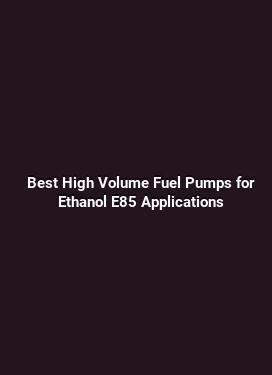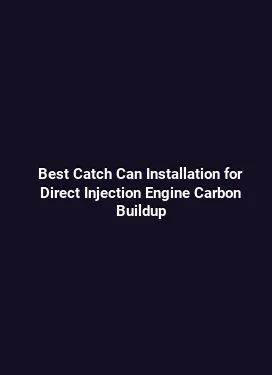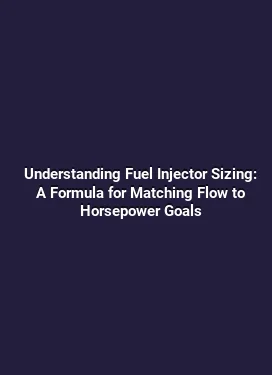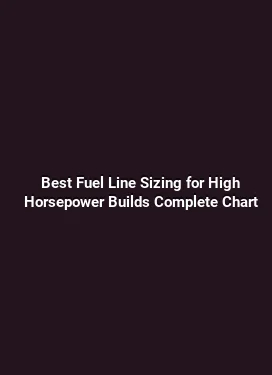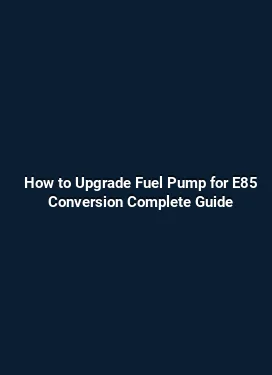Tuning for Ethanol (E85): Fuel System Component Compatibility and Conversion Kits
The adoption of ethanol-based fuels, particularly E85, brings significant opportunities for performance gains and potential cost savings. However, achieving reliable, consistent operation requires careful consideration of the entire intake and fuel system. This article delves into the practical aspects of compatibility, common failure modes, and how to approach conversion kits with a methodical mindset. It emphasizes real-world, hands-on guidance that gearheads, tuners, and enthusiasts can apply without resorting to generic statements. The goal is to provide actionable detail that informs decisions about components, installation, maintenance, and tuning strategies that optimize performance while preserving engine longevity.
First Principles of E85 Compatibility in Intake & Fuel Systems

Ethanol blends such as E85 differ from regular gasoline in several key respects: higher oxygen content, varying stoichiometric air-fuel ratio (AFR) requirements, corrosive tendencies, and pronounced phase separation in certain conditions. Intake and fueling components encounter these differences at multiple contact points—from intake manifolds and fuel injectors to pumps, lines, and seals. A practical approach begins with identifying high-risk areas and then mapping out a plan to mitigate each risk through material selection, tolerances, and calibration adjustments.
One foundational concept is material compatibility. Ethanol is a strong solvent and can degrade certain elastomers, plastics, and coatings used in older fuel systems. It also reduces energy content per gallon, which alters fueling demands. For tuners, the takeaway is to anticipate a slight increase in fuel mass flow with E85 at a given engine load and speed, even before considering timing or boost modifications. This has direct implications for injector sizing, pump capacity, and fuel rail pressure control. A systematic assessment of components—starting with the most exposed parts such as O-rings, seals, and gasket materials—helps prevent leaks and failures after conversion.
Another essential principle is temperature management. Ethanol has different cooling and vaporization characteristics compared to gasoline. In high-load, high-heat scenarios, E85 can exhibit different spray behavior and may require a careful balance of injector spray patterns and intake air temperature management to maintain consistent cylinder charge and avoid lean spikes. Understanding these interactions lays the groundwork for successful hardware decisions and tuning strategies.
Critical Fuel System Components: Compatibility and Selection
Evaluating a fuel system for E85 starts with the most exposed components. The following sections outline practical considerations for intake manifolds, fuel rails, injectors, pumps, lines, filters, and seals. Each subsection includes actionable checks and upgrade paths backed by typical install scenarios, pressure expectations, and service life expectations under E85 use.
Fuel Injectors: Sizing, Flow, and Spray Quality

Injectors must deliver sufficient fuel mass while maintaining precise spray patterns across the engine operating window. When moving to E85, the energy content drop typically requires higher fuel flow for the same power target. A common approach is to select injectors with a higher flow rate and ensure the injector spray pattern remains centered to avoid imbalances in cylinder fueling. Practical steps include: validating static flow at the expected rail pressure, verifying spray cone shape with a testing tool, and confirming end-of-injection behavior during wide-open throttle (WOT) transients. It is also critical to consider injector impedance and compatibility with the ECU or engine management system to prevent misfiring or erratic fueling during startup and cold conditions.
For reference, a typical street setup moving from gasoline to E85 might necessitate a 20–30% increase in injector flow to maintain stoichiometric balance at peak torque, assuming a conservative air intake and a modest boost increase. Always validate with a chassis dynamometer or a trusted engine simulation method to confirm target AFRs across RPM bands rather than relying solely on a static map. An overlooked detail is injector latency at various temperatures; warmer intake air and ethanol-rich fuel can alter the effective pulse width needed to reach target flow, so bench testing at operating temperatures offers valuable insight.
Fuel Pumps and High-Pressure Rails: Ensuring Adequate Capacity
E85 can increase fueling demand, especially in forced-induction applications or engines with larger displacement. A practical rule is to size the pump and rail to comfortably sustain the highest expected pressure and flow during full-load operation with a margin for ethanol’s denser vaporization characteristics. Upgrading to a higher-flow pump with compatible ethanol-rated seals and gaskets helps minimize hot fuel and cavitation risks. When upgrading, verify the pump’s current draw and compatibility with the vehicle’s wiring harness, as ethanol compatibility does not guarantee electrical reliability in high-demand conditions.
Rail pressure should be evaluated in the context of the engine management strategy. If the control strategy uses a returnless system, ensure the regulator sees clean, ethanol-compatible seals and that the rail can absorb pressure transients without leaking or triggering knock retard. A practical diagnostic tip is to monitor rail pressure during a full-range pull and look for pressure drops under sudden throttle changes; persistent dips indicate inadequate pump capacity or line restrictions that may require path improvements or line upgrades.
Fuel Lines, Seals, and Tank Components: Material Integrity
Many modern vehicles already use ethanol-compatible materials in fuel lines and seals, but older builds may require substitutions. Ethanol can degrade natural rubber and certain fluorinated elastomers, leading to leaks or swelling. When planning upgrades, inspect the entire fuel path for compatibility: supply lines, return lines, o-rings in the fuel system, and the tank’s internal components. The practical approach includes selecting lines with ethanol-resistant polymers or molded hoses rated for E85 and ensuring clamps and fittings are corrosion-resistant and compatible with ethanol’s solvent properties.
Tank integrity is critical in high-ethanol blends. Check for fuel pick-up compatibility with ethanol-rich blends to prevent phase separation and clogged pickups. In some designs, ethanol promotes moisture absorption, so ensuring proper venting and sealing is essential to prevent vapor lock and fuel contamination. A routine maintenance habit is to inspect the fuel tank for signs of swollen seals or brittle plastics and replace a suspect component before it fails under load.
Intake Manifold and Air Induction: Managing Charge Cooling and Humidity
Intake systems must ensure a stable, clean air charge when running E85. Ethanol’s cooling effect and higher latent heat of vaporization influence charge temperature and density. Materials in the intake tract should resist ethanol-induced corrosion and not degrade under longer service intervals. Consider lubricants and seals within the throttle body and intake manifolds; use ethanol-compatible lubricants where applicable, especially in high-mileage builds. A practical tip is to monitor ambient and intake air temperatures during tuning sessions; a cooler intake charge can permit higher timing advance, but only if knock thresholds remain safe.
Additionally, cold-start behavior with E85 can differ from gasoline. If cold-start struggles are observed, evaluate fuel richness during cranking and ensure the engine management system can deliver enough fuel without oversaturation. Ethanol-rich fuels may require a brief enrichment during cold starts to prevent misfires and extended cranking times, particularly in climates with low ambient temperatures.
Conversion Kits: Structure, Components, and Best Practices
Conversion kits provide a practical pathway for enthusiasts to transition to E85 without compromising reliability. A well-chosen kit aligns with the vehicle’s engine architecture and the tuning strategy. It typically includes upgraded injectors, fuel pump, pump wiring harness, ethanol-compatible fuel lines, seals, gaskets, and in some cases a controller or calibration files tuned for ethanol compatibility. The best practice is to treat a conversion as a systems upgrade rather than a single part replacement; the total performance and reliability depend on the harmony among components and the calibration strategy.
Key considerations when evaluating a kit include injector compatibility with the vehicle’s ECU, the ability to adjust fueling maps across RPM and load, and the availability of validation data showing AFR stability under various operating conditions. It is also important to verify the kit’s compatibility with the vehicle’s automatic or manual transmission setup, since torque fluency and fuel delivery can impact drivability. Documentation of warranty coverage and post-installation support is a practical signal of a robust kit. A measured approach involves performing staged testing—start with idle and low-load conditions, then proceed to a controlled dyno session to map fueling and ignition across the spectrum, ensuring there are no lean spikes or timing pull that could lead to knock or overheating.
Calibration and Tuning Strategies for E85
Calibration is the fulcrum of a successful E85 setup. Begin with a conservative AFR target that accommodates ethanol’s richer combustion tendency in a naturally aspirated engine and then refine through iterative testing. A typical baseline for a moderately boosted setup might target AFRs in the 11.5–12.0:1 range under peak load, with gradual lean-out permitted in cruising zones to improve efficiency. However, the exact targets depend on engine displacement, compression ratio, turbocharger or supercharger characteristics, and cooling capabilities. It is essential to validate timing maps against knock thresholds and adjust accordingly to preserve reliability while chasing power gains.
Fuel trims and learning behavior should be evaluated to ensure the ECU correctly adapts to ethanol content variations. If the vehicle experiences ethanol content fluctuations, use a flex-fuel sensor or a robust fuel composition sensor to maintain consistent fueling. Implement a staged enrichment protocol during warm-up and a controlled taper during steady-state operation to minimize fuel volatility at the throttle plate and ensure smooth transitions between different loads.
Practical Case Studies: Real-World Examples and Lessons
Case studies provide tangible insights into the challenges and solutions associated with E85 tuning in intake and fuel systems. Example one involves upgrading a turbocharged four-cylinder where the stock fuel rail required reinforcement to handle increased pressure and higher injector demand. The upgrade included a high-capacity ethanol-rated fuel pump, larger injectors, and a revised injector driver strategy. After installation, a staged dyno session revealed a stable AFR curve across the RPM range with a controlled rise in boost pressure, resulting in a reliable power increase without compromising engine health.
Example two focuses on an older vehicle that needed new seals and hoses due to ethanol exposure. The owner replaced several rubber O-rings with ethanol-compatible alternatives and upgraded hose material to resist ethanol interaction. This preventive maintenance reduced leakage risks and improved long-term reliability, particularly in humid climates where ethanol can interact with moisture. These scenarios illustrate the value of combining hardware upgrades with thorough testing to obtain durable performance improvements.
Diagnostics and Maintenance: Staying Ahead of Problems
Routine diagnostics are essential for maintaining a healthy E85-equipped system. Regularly inspect fuel lines for signs of swelling or cracking, verify fuel pressure consistency under load, and monitor AFR behavior during different driving modes. An effective maintenance habit includes checking the integrity of seals and O-rings after a few thousand miles post-conversion since ethanol exposure can reveal latent weaknesses over time. If you notice sudden changes in fuel pressure or inconsistent idle, perform a quick diagnostic sweep with a handheld scanner to interpret any fault codes related to fuel delivery, injection timing, or sensor readings that may indicate calibration drift.
Proactive steps also include checking for moisture-related issues in the fuel system. Ethanol blends can attract moisture, which in turn can impact combustion stability. If you operate in regions with humidity concerns or during extended storage, consider fuel stabilizers and proper fuel curation to minimize phase separation risk. Periodic checks of the fuel tank, lines, and mating surfaces help ensure long-term reliability under ethanol use.
In summary, achieving a successful E85 conversion in the intake and fuel system requires a holistic approach that emphasizes material compatibility, adequate fueling capacity, calibrated control strategies, and proactive maintenance. By aligning upgraded hardware with thoughtful tuning and careful validation, enthusiasts can enjoy the benefits of ethanol blends without compromising engine health or drivability.


